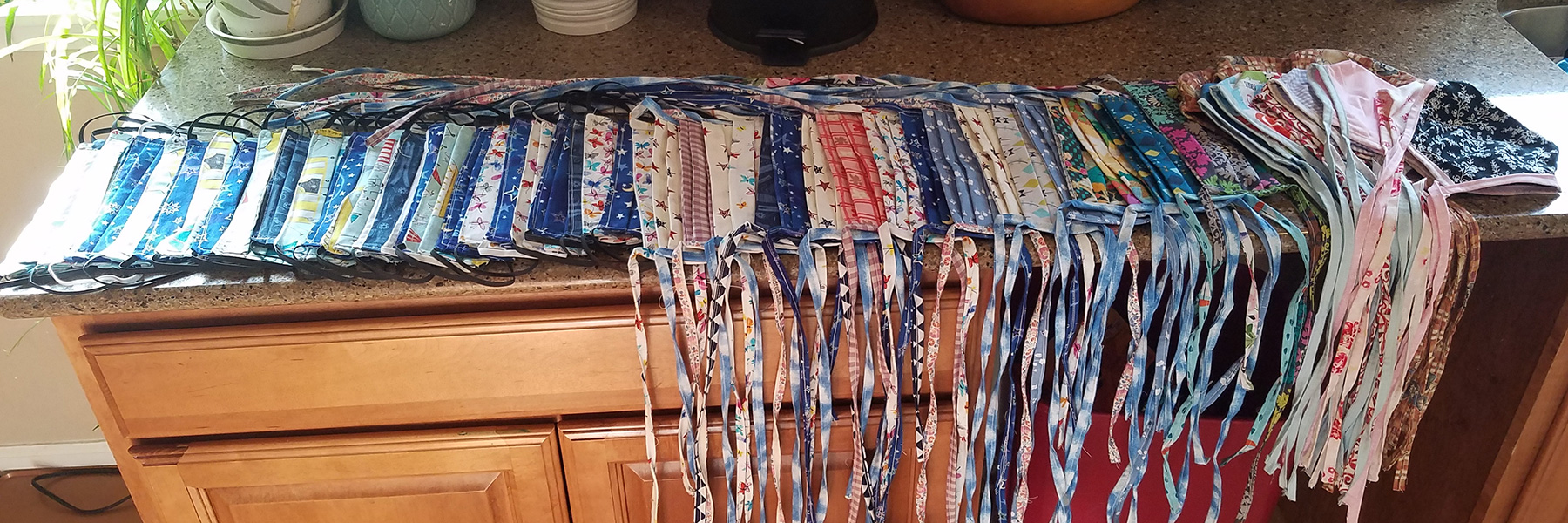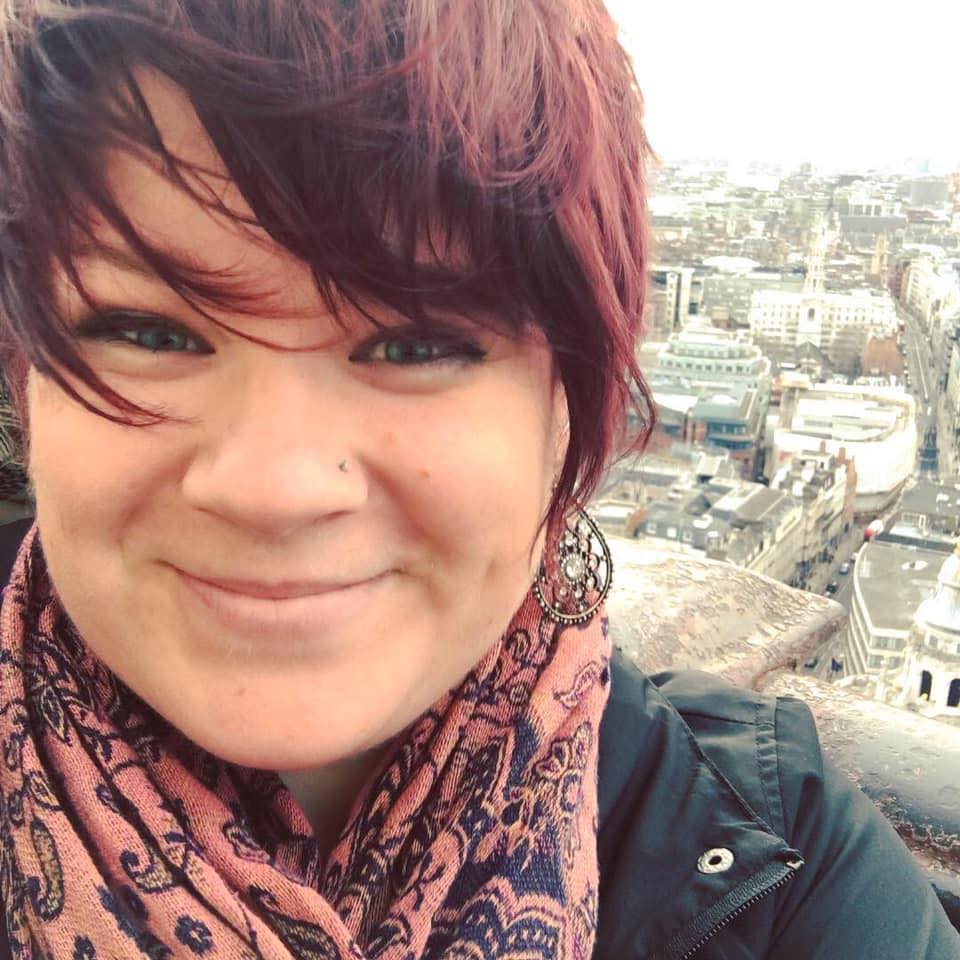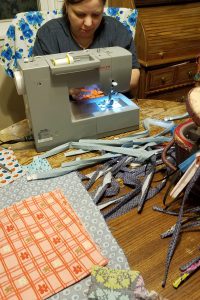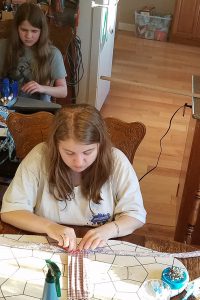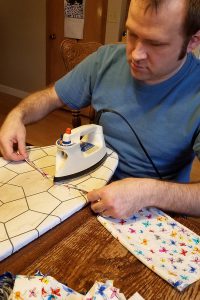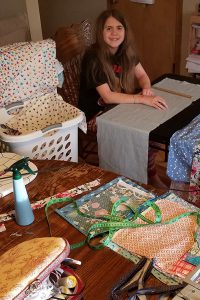By Lance Schwartz • Director of Institutional Communication
Many Bethany alumni are pitching in on the front lines to help their communities, states, and nation during the worldwide pandemic. And as time passes, certainly more stories about the many ways Bethany alumni are making a difference during the time of uncertainty will come to light.
One particular account of two alumnae already making a difference in the early phases of Minnesota’s Stay at Home order is unfolding right in Mankato. A pair of Bethany graduates are using their sewing talents to help many get outfitted with protective masks.
Emily Kimball (’10) is an adjunct theatre department faculty member at Bethany, and she is also Bethany’s costume shop coordinator. That means Kimball is a professional seamstress.
When Bethany made the decision to move all instruction online in March, Kimball’s normal work routine changed considerably. She’s still teaching online, but the other segment of her duties including sewing, fitting, and repairing costumes for all of Bethany’s drama productions took a much lesser role in her daily routine.
“Our spring show, Treasure Island, was postponed until the fall, so I was only halfway done with the costumes. I have five racks of clothes that were ready for fittings when we got back from Spring Break,” explained Kimball.
That’s when Kimball took notice of theatre colleagues from across the country making use of their sewing skills in a different way during the pandemic.
“As a theatrical designer, I’m also a member of several professional costuming groups on Facebook, and the online sewing community was ready to mobilize [making protective masks].”
Kimball’s normal work day at Bethany is full of activity, so this altered version of reality has proven to be somewhat challenging for her.
“I know enough about myself that even if I’m not sewing for the theatre, I need to be doing something productive or my mind turns to mush!”
So Kimball got to work and honed in on a pattern and formula, and the process started to click.
“There was early confusion about the best style, best fabric, best fitting pattern. I didn’t want to embark on a project that might later be deemed ineffectual or something that would lend a false sense of security. So, I began working on a pattern designed by a nurse that was circulating online. Since then, I’ve made two other styles that are intended for at-risk civilians and private use.
“The first round of masks was made out of fabric from both the [Bethany] theatre costume storage and my own fabric stash. I’m always receiving fabric donations and saving any reusable scraps from making costumes. I love sewing with cotton so there are definitely masks out there made with bits of Oklahoma, Brigadoon, and other Bethany shows!”
While the process is working well from her home, Kimball does miss the sewing setup she is most used to in the Ylvisaker Fine Arts Center.
“Since I’m sewing at home, rather than the costume shop at Bethany, my space is much more limited and my iron and tiny pressing board aren’t what I’m used to! I prewash and dry all the fabric (this preshrinks the fabric) and then press it. Then I lay out and cut the pieces. Once pieces are cut, I can make about six of the simplest style masks in an hour.”
Mask creation becomes family affair
In addition to masks for community members and friends, Kimball is also helping to supply some masks to a Mankato area birthing center that she became connected to through alumna Raelene (Miller) Kovaciny (’01). Kovaciny, and her family, are also making masks for those who are requesting.
Kovaciny explained, “I learned on Facebook that some hospitals in other areas were asking for homemade masks since manufactured masks were in short supply, so I started researching what was needed. At that time, I wasn’t aware of any local hospitals that needed them. Then a midwife friend of mine asked if I’d be able to make a few masks for them.
“I was intimidated at first, since it was more than the simple sewing and mending I usually do, so I got in touch with Emily. I had done some volunteer sewing in the Bethany costume shop with her before and knew she’d be helpful. Since we couldn’t visit in person, she made some instructional videos for me to help me understand the process, and was always ready to answer questions and provide feedback.
“I’d finished about a dozen masks when my sister, who is a nurse in St. Louis Park, Minnesota, told me that their neuroscience department had zero masks to use at all. Her department didn’t work directly with known COVID-19 cases, but it was becoming clear that masks were needed, so I enlisted the help of my older children and my husband to ramp up our little home production effort. We picked up some masks that Emily had finished and added them to our pile, and we dropped off a box of 50 masks on my sister’s porch.”
Kovaciny noted that materials for the masks were mostly readily available, except for the bias tape which is used for tie straps. The Kovaciny family assembly crew had to improvise a bit while making their own bias tape, and with that extra effort they are getting the job done.
“Since masks are pretty small, we started with the cotton fabric remnants I had on hand. Emily brought some extra that she had, and then we purchased some additional fabric from local stores. From my sister, sister-in-law, and a friend, I also got donations of fabric, elastic, and the bias tape that we use for tie straps. Local fabric stores are sold out of bias tape, so we have made a lot of the bias tape ourselves.”
The added benefit of the whole Kovaciny family working together to make the masks has helped expedite the assembly process.
“My very first mask took nearly two hours while I tried to learn each step from watching the videos. Now from start to finish is probably about twenty minutes of work, but our kids do much of the measuring, cutting, and ironing of fabric, so I personally spend about twelve minutes on the sewing itself.
“It's definitely a team effort. My sewing machine doesn't always cooperate. And neither do my kids sometimes! But they know it's helping people stay healthy. And we bribe them with jelly beans, so that helps.”
The Kovaciny family factory line turned out a very impressive number of masks just prior to Easter.
“So far, we’ve made 245. About 100 of those went to my sister, and forty to medical workers in the Mankato area. The rest went to “essential” workers, elderly relatives, neighbors, and others. We plan to keep it up as long as there’s a need, and we don’t run out of materials and my sewing machine doesn’t die.”
And the effort has been a welcome diversion to the changed life the Kovaciny family has experienced.
“We are very fortunate to not have been severely affected like so many people. Jon [‘01] works in Bethany’s IT department, and can do his job from home. I am a birth doula and am unable to attend hospital births now due to new restrictions, so I have lost several clients. With our spring calendar cleared by the shutdown, we have had time for more family activities like mask making, board games, and walks on warmer days. Our kids’ teachers at Mt. Olive [Lutheran Grade School] have done a great job of helping us transition to distance learning. The kids weren’t expecting the extra home economics class though!”


